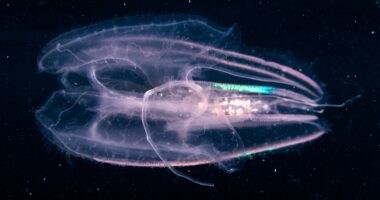NASA recently revealed satellite images of an underwater volcano that erupted in the South Pacific.
The volcano’s real name is Kavachi but it’s also referred to as a ‘sharkcano’ because sharks were spotted living in its acidic waters a few years ago.
The Kavachi volcano in the Solomon Islands erupted earlier this month and evidence of this was captured via Nasa satellites.
It’s unclear what happened to the sharks living inside it but it’s likely they met a boiling death if they were close to the eruption.
Footage captured in a 2015 study revealed two types of shark were living there.
The scientists wrote: “Populations of gelatinous animals, small fish, and sharks were observed inside the active crater, raising new questions about the ecology of active submarine volcanoes and the extreme environments in which large marine animals can exist.”
The sharks were described as “mutants” as they were able to survive in the acidic conditions that should have killed them.
The two species spotted were the silky shark and the hammerhead and we’ve rounded up key facts about each below.
Silky sharks
Mutant silky sharks were spotted living in the sharkcano way before its explosion.
Most read in Tech
They get their name because of their smooth skin.
They’re slender with small dorsel fins and can grow over eight feet.
You can usually find the silky shark in tropical waters all over the world.
Silky sharks have very sharp teeth and could attack a human if they wanted.
However, a silky shark attack is a very rare event as humans aren’t usually in their habitat.
Hammerhead shark
Hammerhead sharks get their name from their unusually shaped heads.
They can grow much bigger than silky sharks and some reach around 20 feet long.
They’re also found in warmer waters all over the world and like to swim together, which is unusual for sharks.


Hammerheads hunt alone at night and usually eat fish, octopuses and squid.
They wouldn’t actively hunt a human but will attack you if provoked.
We pay for your stories!
Do you have a story for The US Sun team?














